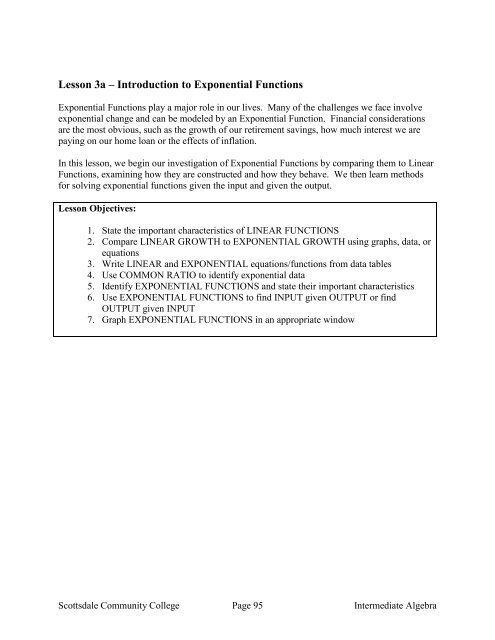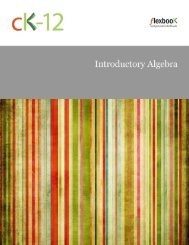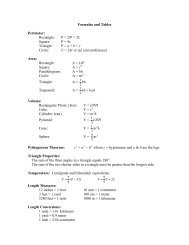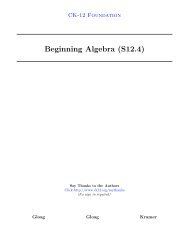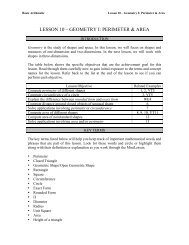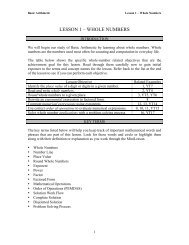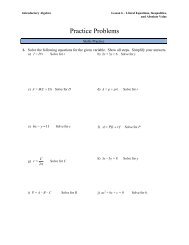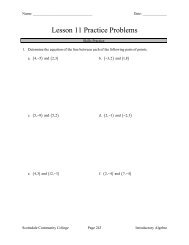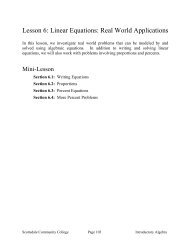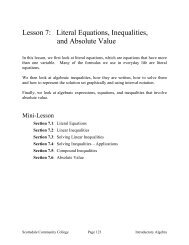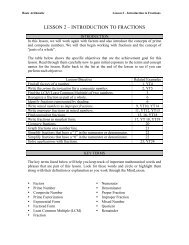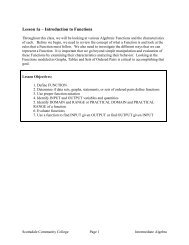Lesson 3a Introduction to Exponential Functions - Scottsdale ...
Lesson 3a Introduction to Exponential Functions - Scottsdale ...
Lesson 3a Introduction to Exponential Functions - Scottsdale ...
Create successful ePaper yourself
Turn your PDF publications into a flip-book with our unique Google optimized e-Paper software.
<strong>Lesson</strong> <strong>3a</strong> – <strong>Introduction</strong> <strong>to</strong> <strong>Exponential</strong> <strong>Functions</strong><br />
<strong>Exponential</strong> <strong>Functions</strong> play a major role in our lives. Many of the challenges we face involve<br />
exponential change and can be modeled by an <strong>Exponential</strong> Function. Financial considerations<br />
are the most obvious, such as the growth of our retirement savings, how much interest we are<br />
paying on our home loan or the effects of inflation.<br />
In this lesson, we begin our investigation of <strong>Exponential</strong> <strong>Functions</strong> by comparing them <strong>to</strong> Linear<br />
<strong>Functions</strong>, examining how they are constructed and how they behave. We then learn methods<br />
for solving exponential functions given the input and given the output.<br />
<strong>Lesson</strong> Objectives:<br />
1. State the important characteristics of LINEAR FUNCTIONS<br />
2. Compare LINEAR GROWTH <strong>to</strong> EXPONENTIAL GROWTH using graphs, data, or<br />
equations<br />
3. Write LINEAR and EXPONENTIAL equations/functions from data tables<br />
4. Use COMMON RATIO <strong>to</strong> identify exponential data<br />
5. Identify EXPONENTIAL FUNCTIONS and state their important characteristics<br />
6. Use EXPONENTIAL FUNCTIONS <strong>to</strong> find INPUT given OUTPUT or find<br />
OUTPUT given INPUT<br />
7. Graph EXPONENTIAL FUNCTIONS in an appropriate window<br />
<strong>Scottsdale</strong> Community College Page 95 Intermediate Algebra
<strong>Lesson</strong> <strong>3a</strong> Checklist<br />
Component<br />
Required<br />
Y or N<br />
Comments Due Score<br />
Mini-<strong>Lesson</strong><br />
Online<br />
Homework<br />
Online<br />
Quiz<br />
Online<br />
Test<br />
Practice<br />
Problems<br />
<strong>Lesson</strong><br />
Assessment<br />
<strong>Scottsdale</strong> Community College Page 96 Intermediate Algebra
Name: _____________________<br />
Date: ________________<br />
<strong>Exponential</strong> <strong>Functions</strong> vs. Linear <strong>Functions</strong><br />
Mini-<strong>Lesson</strong> <strong>3a</strong><br />
So far in this course, the only function type we have studied is LINEAR FUNCTIONS. You<br />
spent the first lessons learning the characteristics of LINEAR FUNCTIONS. Let’s remind<br />
ourselves of those now.<br />
Problem 1 YOU TRY – CHARACTERISTICS OF LINEAR FUNCTIONS<br />
Given a function, f(x) = mx + b, respond <strong>to</strong> each of the following. Refer back <strong>to</strong> previous<br />
lessons as needed.<br />
a) The variable x represents the _________ quantity.<br />
b) f(x) represents the ________ quantity. f(x) is just another name for _____________ .<br />
c) The graph of f(x) is a _______________________ with slope __________ and<br />
y-intercept ___________ .<br />
d) On the graphing grid below, draw an INCREASING linear function. In this case, what<br />
can you say about the slope of the line m ______ 0 (Your choices here are > or or
<strong>Lesson</strong> <strong>3a</strong> – <strong>Introduction</strong> <strong>to</strong> <strong>Exponential</strong> <strong>Functions</strong><br />
Mini-<strong>Lesson</strong><br />
This next example is long but will illustrate the key difference between EXPONENTIAL<br />
FUNCTIONS and LINEAR FUNCTIONS.<br />
Problem 2 WORKED EXAMPLE – DOLLARS & SENSE<br />
On December 31st around 10 pm, you are sitting quietly in your house watching Dick Clark's<br />
New Year's Eve special when there is a knock at the door. Wondering who could possibly be<br />
visiting at this hour you head <strong>to</strong> the front door <strong>to</strong> find out who it is. Seeing a man dressed in a<br />
three-piece suit and tie and holding a briefcase, you cautiously open the door.<br />
The man introduces himself as a lawyer representing the estate of your recently deceased great<br />
uncle. Turns out your uncle left you some money in his will, but you have <strong>to</strong> make a decision.<br />
The man in the suit explains that you have three options for how <strong>to</strong> receive your allotment.<br />
Option A: $1000 would be deposited on Dec 31st in a bank account bearing your name and each<br />
day an additional $1000 would be deposited (until January 31st).<br />
Option B: One penny would be deposited on Dec 31st in a bank account bearing your name.<br />
Each day, the amount would be doubled (until January 31st).<br />
Option C: Take $30,000 on the spot and be done with it.<br />
Given that you had been <strong>to</strong> a party earlier that night and your head was a little fuzzy, you wanted<br />
some time <strong>to</strong> think about it. The man agreed <strong>to</strong> give you until 11:50 pm. Which option would<br />
give you the most money after the 31 days<br />
A table of values for option A and B are provided on the following page. Before you look at the<br />
values, though, which option would you select according <strong>to</strong> your intuition<br />
Without “doing the math” first, I would instinctively choose the following option (circle<br />
your choice):<br />
Option Option Option<br />
A B C<br />
<strong>Scottsdale</strong> Community College Page 98 Intermediate Algebra
<strong>Lesson</strong> <strong>3a</strong> – <strong>Introduction</strong> <strong>to</strong> <strong>Exponential</strong> <strong>Functions</strong><br />
Mini-<strong>Lesson</strong><br />
Option A:<br />
$1000 <strong>to</strong> start + $1000 per day<br />
Option B:<br />
$.01 <strong>to</strong> start then double each day<br />
Note that t = 0 on Dec. 31st<br />
Table of input/output values<br />
Table of input/output values<br />
t =<br />
time in # of<br />
days<br />
A(t)=<br />
$ in account after t days<br />
t =<br />
time in # of<br />
days<br />
B(t) =<br />
$ in account after t<br />
days<br />
0 1000<br />
1 2000<br />
2 3000<br />
3 4000<br />
4 5000<br />
5 6000<br />
6 7000<br />
7 8000<br />
8 9000<br />
9 10,000<br />
10 11,000<br />
11 12,000<br />
12 13,000<br />
13 14,000<br />
14 15,000<br />
15 16,000<br />
16 17,000<br />
17 18,000<br />
18 19,000<br />
19 20,000<br />
20 21,000<br />
21 22,000<br />
22 23,000<br />
23 24,000<br />
24 25,000<br />
25 26,000<br />
26 27,000<br />
27 28,000<br />
28 29,000<br />
29 30,000<br />
30 31,000<br />
31 32,000<br />
0 .01<br />
1 .02<br />
2 .04<br />
3 .08<br />
4 .16<br />
5 .32<br />
6 .64<br />
7 1.28<br />
8 2.56<br />
9 5.12<br />
10 10.24<br />
11 20.48<br />
12 40.96<br />
13 81.92<br />
14 163.84<br />
15 327.68<br />
16 655.36<br />
17 1,310.72<br />
18 2,621.44<br />
19 5,242.88<br />
20 10,485.76<br />
21 20,971.52<br />
22 41,943.04<br />
23 83,886.08<br />
24 167,772.16<br />
25 335,544.32<br />
26 671,088.64<br />
27 1,342,177.28<br />
28 2,684,354.56<br />
29 5,368,709.12<br />
30 10,737,418.24<br />
31 21,474,836.48<br />
WOWWWWW!!!!!!!<br />
What IS that number for Option B I hope you made that choice… it’s 21 million, 4 hundred 74<br />
thousand, 8 hundred 36 dollars and 48 cents. Let’s see if we can understand what is going on<br />
with these different options.<br />
<strong>Scottsdale</strong> Community College Page 99 Intermediate Algebra
<strong>Lesson</strong> <strong>3a</strong> – <strong>Introduction</strong> <strong>to</strong> <strong>Exponential</strong> <strong>Functions</strong><br />
Mini-<strong>Lesson</strong><br />
Problem 3 MEDIA EXAMPLE – COMPARE LINEAR AND EXPONENTIAL<br />
GROWH<br />
For the example discussed in Problem 2, respond <strong>to</strong> the following:<br />
a) Symbolic representation (model) for each situation:<br />
A(t) =<br />
B(t) =<br />
C(t) =<br />
Type of function __________________<br />
Type of function __________________<br />
Type of function __________________<br />
b) Provide a rough but accurate sketch of the graphs for each function on the same grid below:<br />
c) What are the practical domain and range for each function<br />
Practical Domain<br />
Practical Range<br />
A(t):<br />
B(t):<br />
C(t):<br />
d) Based on the graphs, which option would give you the most money after 31 days<br />
<strong>Scottsdale</strong> Community College Page 100 Intermediate Algebra
<strong>Lesson</strong> <strong>3a</strong> – <strong>Introduction</strong> <strong>to</strong> <strong>Exponential</strong> <strong>Functions</strong><br />
Mini-<strong>Lesson</strong><br />
e) Let’s see if we can understand WHY option B grows so much faster. Let’s focus just on<br />
options A and B. Take a look at the data tables given for each function. Just the later parts of the<br />
initial table are provided.<br />
t =<br />
time in # of<br />
days<br />
A(t) = 1000t + 1000<br />
A(t)=<br />
$ in account after t days<br />
20 21,000<br />
21 22,000<br />
22 23,000<br />
23 24,000<br />
24 25,000<br />
25 26,000<br />
26 27,000<br />
27 28,000<br />
28 29,000<br />
29 30,000<br />
30 31,000<br />
31 32,000<br />
t =<br />
time in # of<br />
days<br />
B(t) = .01(2) t<br />
B(t) =<br />
$ in account after t<br />
days<br />
20 10,485.76<br />
21 20,971.52<br />
22 41,943.04<br />
23 83,886.08<br />
24 167,772.16<br />
25 335,544.32<br />
26 671,088.64<br />
27 1,342,177.28<br />
28 2,684,354.56<br />
29 5,368,709.12<br />
30 10,737,418.24<br />
31 21,474,836.48<br />
As t increases from day 20 <strong>to</strong> 21, describe how the outputs change for each function:<br />
A(t):<br />
B(t):<br />
As t increases from day 23 <strong>to</strong> 24, describe how the outputs change for each function:<br />
A(t):<br />
B(t):<br />
So, in general, we can say as the inputs increase from one day <strong>to</strong> the next, then the outputs for<br />
each function:<br />
A(t):<br />
B(t):<br />
In other words, A(t) grows ______________ and B(t) grows ______________. We have just<br />
identified the primary difference between LINEAR FUNCTIONS and EXPONENTIAL<br />
FUNCTIONS.<br />
<strong>Exponential</strong> <strong>Functions</strong> vs. Linear <strong>Functions</strong><br />
The outputs for Linear <strong>Functions</strong> change by ADDITION and the outputs for<br />
<strong>Exponential</strong> <strong>Functions</strong> change by MULTIPLICATION.<br />
<strong>Scottsdale</strong> Community College Page 101 Intermediate Algebra
<strong>Lesson</strong> <strong>3a</strong> – <strong>Introduction</strong> <strong>to</strong> <strong>Exponential</strong> <strong>Functions</strong><br />
Mini-<strong>Lesson</strong><br />
Problem 4 WORKED EXAMPLE – ARE THE DATA EXPONENTIAL<br />
To determine if an exponential function is the best model for a given data set, calculate the ratio<br />
y 2<br />
for each of the consecutive points. If this ratio is approximately the same for the entire set,<br />
y 1<br />
then an exponential function models the data best. For example:<br />
x 1 2 3 4 5<br />
y 1.75 7 28 112 448<br />
y 2<br />
For this set of data,<br />
Since = 4 for all consecutive pairs, the data are exponential with a growth fac<strong>to</strong>r of 4.<br />
y 1<br />
Problem 5 MEDIA EXAMPLE – LINEAR DATA VS. EXPONENTIAL DATA<br />
Analyze each of the following data sets <strong>to</strong> determine if the set can be modeled best by a linear<br />
function or an exponential function. Write the equation that goes with each data set.<br />
x -1 -2 0 1 2 3 4<br />
y<br />
1<br />
25<br />
1 5 25 125 625<br />
x 0 1 2 3 4 5 6 7<br />
y -3.2 -3 -2.8 -2.6 -2.4 -2.2 -2.0 -1.8<br />
<strong>Scottsdale</strong> Community College Page 102 Intermediate Algebra
<strong>Lesson</strong> <strong>3a</strong> – <strong>Introduction</strong> <strong>to</strong> <strong>Exponential</strong> <strong>Functions</strong><br />
Mini-<strong>Lesson</strong><br />
Problem 6 YOU TRY – USE COMMON RATIO TO IDENTIFY EXPONENTIAL<br />
DATA<br />
a) Given the following table, explain why the data can be best modeled by an exponential<br />
function. Use the idea of common ratio in your response.<br />
x 0 1 2 3 4 5 6<br />
f(x) 5.0 7.5 11.2 16.9 25.3 37.9 57.0<br />
b) Determine an exponential model f(x) = ab x that fits these data. Start by identifying the values<br />
of a and b then writing your final result using proper notation.<br />
<strong>Exponential</strong> <strong>Functions</strong> are of the form<br />
f(x) = ab x<br />
where a = the INITIAL VALUE<br />
b = the base (b > 0 and b ≠ 1) also called the GROWTH or DECAY FACTOR<br />
Important Characteristics of the EXPONENTIAL FUNCTION f(x) = ab x<br />
<br />
<br />
<br />
<br />
<br />
<br />
x represents the INPUT quantity<br />
f(x) represents the OUTPUT quantity (where f(x) really just means “y”)<br />
The graph of f(x) is in the shape of the letter “J” with y-intercept (0, a) and base, b (note<br />
that b is the same as the COMMON RATIO from previous examples)<br />
If b>1, the function is an EXPONENTIAL GROWTH function and the graph<br />
INCREASES from L <strong>to</strong> R<br />
If 0
<strong>Lesson</strong> <strong>3a</strong> – <strong>Introduction</strong> <strong>to</strong> <strong>Exponential</strong> <strong>Functions</strong><br />
Mini-<strong>Lesson</strong><br />
Graph of a generic <strong>Exponential</strong> Growth Function<br />
f(x) = ab x , b > 1<br />
Domain: All Real Numbers (all inputs)<br />
Range: f(x)>0 (only outputs bigger than 0)<br />
X-intercept: None (graph does not cross x-axis)<br />
Y-intercept: (0, a)<br />
Horizontal Asymp<strong>to</strong>te: y = 0 (guiding line for the left side of<br />
the graph is the x-axis or y = 0)<br />
Left <strong>to</strong> right behavior of the function: Y-values INCREASING<br />
<br />
Graph of a generic <strong>Exponential</strong> Decay Function<br />
f(x) = ab x , 0 < b < 1<br />
Domain: All Real Numbers (all inputs)<br />
Range: f(x)>0 (only outputs bigger than 0)<br />
X-intercept: None (graph does not cross x-axis)<br />
Y-intercept: (0, a)<br />
Horizontal Asymp<strong>to</strong>te: y = 0 (guiding line for the right side of<br />
the graph is the x-axis or y = 0)<br />
Left <strong>to</strong> right behavior of the function: Y-values DECREASING<br />
Problem 7<br />
WORKED EXAMPLE – Examples of <strong>Exponential</strong> <strong>Functions</strong><br />
a) f(x) = 2(3) x Initial Value, a = 2, y-intercept = (0, 2)<br />
Base, b = 3.<br />
f(x) is an exponential GROWTH function since b > 1.<br />
b) g(x) =1523(1.05) x Initial Value, a = 1523, y-intercept = (0, 1523)<br />
Base, b = 1.05.<br />
g(x) is an exponential GROWTH function since b > 1.<br />
c) h(x) = 256(0.85) x Initial Value, a = 256, y-intercept = (0, 256)<br />
Base, b = 0.85.<br />
h(x) is an exponential DECAY function since b < 1.<br />
d) k(x) = 32(0.956) x Initial Value, a = 32, y-intercept = (0, 32)<br />
Base, b = 0.956.<br />
k(x) is an exponential DECAY function since b < 1.<br />
<strong>Scottsdale</strong> Community College Page 104 Intermediate Algebra
<strong>Lesson</strong> <strong>3a</strong> – <strong>Introduction</strong> <strong>to</strong> <strong>Exponential</strong> <strong>Functions</strong><br />
Mini-<strong>Lesson</strong><br />
Problem 8 YOU TRY – CHARACTERISTICS OF EXPONENTIAL FUNCTIONS<br />
Complete the table using the graphs <strong>to</strong> assist you. You should enter the graphs on your calcula<strong>to</strong>r<br />
as well using the screens below <strong>to</strong> help you.<br />
<strong>Functions</strong> are entered on the Y= screen<br />
Press WINDOW <strong>to</strong> change your values as shown below<br />
Press GRAPH <strong>to</strong> show the graphs<br />
f(x) = 125(1.25) x<br />
g(x) = 125(0.75) x<br />
Initial Value (a)<br />
Base (b)<br />
Domain<br />
Range<br />
X-intercept<br />
Y-intercept<br />
Horizontal Asymp<strong>to</strong>te<br />
Increasing or Decreasing<br />
f(x) = 125(1.25) x<br />
g(x) = 125(0.75) x<br />
<strong>Scottsdale</strong> Community College Page 105 Intermediate Algebra
<strong>Lesson</strong> <strong>3a</strong> – <strong>Introduction</strong> <strong>to</strong> <strong>Exponential</strong> <strong>Functions</strong><br />
Mini-<strong>Lesson</strong><br />
When working with EXPONENTIAL FUNCTIONS, as with LINEAR FUNCTIONS, there are<br />
two main questions we will ask and solve as follows:<br />
<br />
<br />
Given a particular INPUT value, what is the corresponding OUTPUT value<br />
Given a particular OUTPUT value, what is the corresponding INPUT value<br />
Problem 9 MEDIA EXAMPLE – GIVEN INPUT FIND OUTPUT<br />
Use the functions f(x) = 125(1.25) x and g(x) = 125(0.75) x <strong>to</strong> respond <strong>to</strong> the questions below.<br />
a) Find f(x) when x = 2. b) Find g(x) when x = 2.<br />
c) Find f(x) when x = -4. d) Find g(x) when x = -4.<br />
Problem 10<br />
WORKED EXAMPLE – GIVEN OUTPUT FIND INPUT<br />
Given f(x) = 125(1.25) x find x when f(x) = 300. Round your respond <strong>to</strong> two decimal places.<br />
To do this, we need <strong>to</strong> SOLVE the equation 125(1.25) x = 300 using a process called the<br />
INTERSECTION METHOD on our graphing calcula<strong>to</strong>rs.<br />
To solve 125(1.25) x = 300<br />
Press Y= then enter Y1 = 125(1.25) x and Y2 = 300<br />
Note: You could also let Y1 = 300 and Y2=125(1.25) x<br />
<br />
Press WINDOW then enter the values at right.<br />
Try <strong>to</strong> determine why these values were selected. You must<br />
see the intersection in your window. Other entries will<br />
work. If you graph and do not see both graphs AND where<br />
they intersect, you must pick new WINDOW values until<br />
you do.<br />
KEEP GOING ON THE NEXT PAGE<br />
<strong>Scottsdale</strong> Community College Page 106 Intermediate Algebra
<strong>Lesson</strong> <strong>3a</strong> – <strong>Introduction</strong> <strong>to</strong> <strong>Exponential</strong> <strong>Functions</strong><br />
Mini-<strong>Lesson</strong><br />
Press 2 nd >CALC<br />
Scroll <strong>to</strong> 5: INTERSECT and press ENTER<br />
Notice the question, “First Curve” The calcula<strong>to</strong>r is<br />
asking if<br />
Y1 = 125(1.25) x is the first curve in the intersection.<br />
Press Enter <strong>to</strong> indicate “Yes”<br />
Notice the question, “Second Curve” The calcula<strong>to</strong>r is<br />
asking if<br />
Y2 = 300 is the second curve in the intersection.<br />
Press Enter <strong>to</strong> indicate “Yes”<br />
<br />
Press Enter at the “Guess” question and obtain the<br />
screen at right. Your intersection values are given<br />
at screen bot<strong>to</strong>m and the intersection is marked<br />
with a cursor. Round as indicated in your problem<br />
directions or as dictated by the situation.<br />
For this problem, we were asked <strong>to</strong> find x when f(x) = 300. Round <strong>to</strong> two decimal places. Our<br />
response is that, “When f(x) = 300, x = 3.92”. Note that this information corresponds <strong>to</strong> the<br />
ordered pair (3.92, 300) on the graph of f(x) = 125(1.25) x<br />
Problem 11<br />
YOU TRY – GIVEN OUTPUT FIND INPUT<br />
Given g(x) = 125(0.75) x , find x when g(x) = 300 (<strong>to</strong> two decimal places) using the same process<br />
as above.<br />
a) What equation will you solve <strong>to</strong> respond <strong>to</strong> the given question __________________<br />
b) On your calcula<strong>to</strong>r, you will let Y1 = ________________ and Y2 = _______________<br />
c) What values are you using for your WINDOW: xmin=____, xmax=_____, ymin=____,<br />
ymax=____<br />
d) What is the value of x that you found when g(x) = 300 _________________________<br />
(using 5: INTERSECT)<br />
e) To what ordered pair does this information correspond _______________<br />
f) Include a rough but accurate sketch of the graphs and<br />
intersection in the box <strong>to</strong> the right. Mark and label the<br />
intersection.<br />
<strong>Scottsdale</strong> Community College Page 107 Intermediate Algebra
<strong>Lesson</strong> <strong>3a</strong> – <strong>Introduction</strong> <strong>to</strong> <strong>Exponential</strong> <strong>Functions</strong><br />
Mini-<strong>Lesson</strong><br />
Problem 12<br />
WORKED EXAMPLE – GIVEN OUTPUT FIND INPUT<br />
Given f(x) = 125(1.25) x find x when f(x) = 50. Round your respond <strong>to</strong> two decimal places.<br />
To do this, we need <strong>to</strong> SOLVE the equation 125(1.25) x = 50 using a process called the<br />
INTERSECTION METHOD on our graphing calcula<strong>to</strong>rs.<br />
To solve 125(1.25) x = 50<br />
Press Y= then enter Y1 = 125(1.25) x and Y2 = 50<br />
Note: You could also let Y1 = 50 and Y2=125(1.25) x<br />
<br />
Press WINDOW then enter the values at right.<br />
Try <strong>to</strong> determine why these values were selected. You must<br />
see the intersection in your window. Other entries will<br />
work. If you graph and do not see both graphs AND where<br />
they intersect, you must pick new WINDOW values until<br />
you do.<br />
Press 2 nd >CALC<br />
Scroll <strong>to</strong> 5: INTERSECT and press ENTER<br />
Notice the question, “First Curve” The calcula<strong>to</strong>r is<br />
asking if<br />
Y1 = 125(1.25) x is the first curve in the intersection.<br />
Press Enter <strong>to</strong> indicate “Yes”<br />
Notice the question, “Second Curve” The calcula<strong>to</strong>r is<br />
asking if<br />
Y2 = 50 is the second curve in the intersection.<br />
Press Enter <strong>to</strong> indicate “Yes”<br />
<br />
Press Enter at the “Guess” question and obtain the<br />
screen at right. Your intersection values are given<br />
at screen bot<strong>to</strong>m and the intersection is marked<br />
with a cursor. Round as indicated in your problem<br />
directions or as dictated by the situation.<br />
For this problem, we were asked <strong>to</strong> find x when f(x) = 50. Round <strong>to</strong> two decimal places. Our<br />
response is that, “When f(x) = 50, x = -4.11”. Note that this information corresponds <strong>to</strong> the<br />
ordered pair (-4.11, 50) on the graph of f(x) = 125(1.25) x<br />
<strong>Scottsdale</strong> Community College Page 108 Intermediate Algebra
<strong>Lesson</strong> <strong>3a</strong> – <strong>Introduction</strong> <strong>to</strong> <strong>Exponential</strong> <strong>Functions</strong><br />
Mini-<strong>Lesson</strong><br />
Problem 13<br />
YOU TRY – GIVEN OUTPUT FIND INPUT<br />
Given g(x) = 125(0.75) x , find x when g(x) = 50 (<strong>to</strong> two decimal places) using the same process<br />
as above.<br />
a) What equation will you solve <strong>to</strong> respond <strong>to</strong> the given question __________________<br />
b) On your calcula<strong>to</strong>r, you will let Y1 = ________________ and Y2 = _______________<br />
c) What values are you using for your WINDOW: xmin=____, xmax=_____,<br />
ymin=____, ymax=____<br />
d) What is the value of x that you found when g(x) = 50 _______________ (using 5:<br />
INTERSECT)<br />
e) To what ordered pair does this information correspond _______________<br />
f) Include a rough but accurate sketch of the graphs and intersection on the grid below. Mark<br />
and label the intersection.<br />
<strong>Scottsdale</strong> Community College Page 109 Intermediate Algebra
<strong>Lesson</strong> <strong>3a</strong> – <strong>Introduction</strong> <strong>to</strong> <strong>Exponential</strong> <strong>Functions</strong><br />
Mini-<strong>Lesson</strong><br />
Writing <strong>Exponential</strong> Equations/<strong>Functions</strong><br />
Given a set of data that can be modeled using an exponential equation, use the steps below <strong>to</strong><br />
determine the particulars of the equation:<br />
1. Identify the initial value. This is the a part of the exponential equation y = ab x . To find<br />
a, look for the starting value of the data set (the output that goes with input 0).<br />
2. Identify the common ratio, b, value. To do this, make a fraction of two consecutive<br />
outputs (as long as the inputs are separated by exactly 1). We write this as the fraction<br />
y 2<br />
y 1<br />
<strong>to</strong> indicate that we put the second y on <strong>to</strong>p and the first on the bot<strong>to</strong>m. Simplify this<br />
fraction and round as the problem indicates <strong>to</strong> obtain the value of b.<br />
3. Plug in the values of a and b in<strong>to</strong> y = ab x <strong>to</strong> write the exponential equation.<br />
4. Replace y with appropriate notation as needed <strong>to</strong> identify a requested exponential<br />
FUNCTION.<br />
Problem 14<br />
MEDIA EXAMPLE – WRITING EXPONENTIAL<br />
EQUATIONS/FUNCTIONS<br />
The growth of the population of a small city is shown in the following table:<br />
Year<br />
Population<br />
2000 12,545<br />
2001 15269<br />
2002 18584<br />
Assume this growth is exponential. Let t = 0 represent the year 2000 and let a equal the initial<br />
population in 2000. Let b equal the ratio in population between the years 2001 and 2000.<br />
a) Write the equation of the exponential mathematical model for this situation. Round any<br />
decimals <strong>to</strong> two places. Be sure your final result uses proper function notation.<br />
b) Using this model, forecast the population in 2008 (<strong>to</strong> the nearest person).<br />
c) Also using this model, determine the nearest whole year in which the population will reach<br />
50,000.<br />
<strong>Scottsdale</strong> Community College Page 110 Intermediate Algebra
<strong>Lesson</strong> <strong>3a</strong> – <strong>Introduction</strong> <strong>to</strong> <strong>Exponential</strong> <strong>Functions</strong><br />
Mini-<strong>Lesson</strong><br />
GUIDELINES FOR SELECTING WINDOW VALUES FOR INTERSECTIONS<br />
While the steps for using the INTERSECTION method are straightforward, choosing values for<br />
your window are not always easy. Here are some guidelines for choosing the edges of your<br />
window:<br />
<br />
<br />
First and foremost, the intersection of the equations MUST appear clearly in the window<br />
you select. Try <strong>to</strong> avoid intersections that appear just on the window’s edges, as these are<br />
hard <strong>to</strong> see and your calcula<strong>to</strong>r will often not process them correctly.<br />
Second, you want <strong>to</strong> be sure that other important parts of the graphs appear (i.e. where<br />
the graph or graphs cross the y-axis or the x-axis).<br />
When choosing values for x, start with the standard XMin = -10 and Xmax = 10<br />
UNLESS the problem is a real-world problem. In that case, start with Xmin=0 as<br />
negative values for a world problem are usually not important. If the values for Xmax<br />
need <strong>to</strong> be increased, choose 25, then 50, then 100 until the intersection of graphs is<br />
visible.<br />
<br />
When choosing values for y, start with Ymin = 0 negative values of Y are needed for<br />
some reason. For Ymax, all equations I am working with need <strong>to</strong> appear. So, if solving<br />
something like 234(1.23) x = 1000, then choose Ymax <strong>to</strong> be bigger than 1000 (say, 1500).<br />
If the intersection does not appear in the window, then try <strong>to</strong> change only one window setting at<br />
a time so you can clearly identify the effect of that change (i.e. make Xmax bigger OR change<br />
Ymax but not both at once). Try <strong>to</strong> think about the functions you are working with and what they<br />
look like and use a systematic approach <strong>to</strong> making changes.<br />
Problem 15<br />
YOU TRY – WINDOW VALUES AND INTERSECTIONS<br />
In each situation below, you will need <strong>to</strong> graph <strong>to</strong> find the solution <strong>to</strong> the equation using the<br />
INTERSECTION method described in this lesson. Fill in the missing information for each<br />
situation.<br />
a) Solve 54(1.05) x =250 Y1=________ WINDOW Xmin=____, Xmax= ______<br />
Y2 = _______<br />
Ymin=____, Ymax= ______<br />
Solution: x = ______________ Round <strong>to</strong> two decimals.<br />
b) Solve 2340(0.82) x = 1250 Y1=________ WINDOW Xmin=____, Xmax= ______<br />
Y2 = _______<br />
Ymin=____, Ymax= ______<br />
Solution: x = ______________ Round <strong>to</strong> two decimals.<br />
c) Solve 45=250(1.045) x Y1=________ WINDOW Xmin=____, Xmax= ______<br />
Y2 = _______<br />
Ymin=____, Ymax= ______<br />
Solution: x = ______________ Round <strong>to</strong> two decimals.<br />
<strong>Scottsdale</strong> Community College Page 111 Intermediate Algebra
<strong>Lesson</strong> <strong>3a</strong> – <strong>Introduction</strong> <strong>to</strong> <strong>Exponential</strong> <strong>Functions</strong><br />
Mini-<strong>Lesson</strong><br />
<strong>Scottsdale</strong> Community College Page 112 Intermediate Algebra


